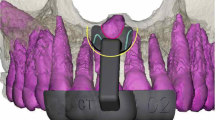Abstract
Background
Although a large number of mesiodentes are left in situ, only a few are found in radiographs from epidemiological studies of adult populations. This leads to the development of a hypothesis that mesiodentes may be resorbed and disappear over time. The aim of this study was to radiographically investigate the frequency of resorptions and pathologies in relation to mesiodentes left in situ.
Methods
The study population consisted of 44 individuals, with 49 mesiodentes left in situ at an early age. The individuals were 18–38 years old when re-examined. The inclusion criteria were that the mesiodentes had been diagnosed in childhood and left in situ, and that each individual was over 18 years of age at the time of re-examination. Either digital or analogue intraoral radiographs were used at the re-examination and compared with earlier analogue radiographs.
Results
Forty-one per cent of the impacted mesiodentes showed resorptions—from limited to nearly complete resorption. No pathologies in connection to the mesiodentes were found.
Conclusion
About half of the mesiodentes examined displayed resorption. No pathologies caused by the mesiodentes were recorded.



Similar content being viewed by others
References
Anthonappa RP, King NM, Rabie AB. Aetiology of supernumerary teeth: a literature review. Eur Arch Paediatr Dent. 2013;14:279–88.
Asaumi JI, Shibata Y, Yanagi Y, Hisatomi M, Matsuzaki H, Konouchi H, Kishi K. Radiographic examination of mesiodens and their associated complications. Dentomaxillofac Radiol. 2004;33:125–7.
Baysal MC. Supernumerary teeth in children. Dent Dig. 1964;70:506–9.
Bjerklin K, Bondemark L. Ectopic maxillary canines and root resorption of adjacent incisors. Does computed tomography (CT) influence decision-making by orthodontists? Swed Dent J. 2008;32:179–85.
Bodin I, Julin P, Thomsson M. Hyperodontia. III. Supernumerary anterior teeth. Dentomaxillofac Radiol. 1981;10:35–42.
Bolk L. The supernumerary upper incisor in man. Deutsche Monatschr P Zahn. 1917;35:185–228.
D’Souza RN, Klein OD. Unraveling the molecular mechanisms that lead to supernumerary teeth in mice and men: current concepts and novel approaches. Cells Tissues Organs. 2007;186:60–9.
Hugoson A, Koch G, Bergendal T, et al. Oral health of individuals aged 3–80 years in Jonkoping, Sweden in 1973, 1983, and 1993. II. Review of clinical and radiographic findings. Swed Dent J. 1995;19:243–60.
Hurlen B, Humerfelt D. Characteristics of premaxillary hyperodontia. A radiographic study. Acta Odontol Scand. 1985;43:75–81.
Hyun HK, Lee SJ, Lee SH, Hahn SH, Kim JW. Clinical characteristics and complications associated with mesiodentes. J Oral Maxillofac Surg. 2009;67:2639–43.
Koch H, Schwartz O, Klausen B. Indications for surgical removal of supernumerary teeth in the premaxilla. Int J Oral Maxillofac Surg. 1986;15:273–81.
Lara TS, Lancia M, Da Silva Filho OG, Garib DG, Ozawa TO. Prevalence of mesiodens in orthodontic patients with deciduous and mixed dentition and its association with other dental anomalies. Dental Press J Orthod. 2013;18:93–9.
Mason C, Azam N, Holt RD, Rule DC. A retrospective study of unerupted maxillary incisors associated with supernumerary teeth. Br J Oral Maxillofac Surg. 2000;38:62–5.
Ne RF, Witherspoon DE, Gutmann JL. Tooth resorption. Quintessence Int. 1999;30:9–25.
Ngan DC, Kharbanda OP, Geenty JP, Darendeliler MA. Comparison of radiation levels from computed tomography and conventional dental radiographs. Aust Orthod J. 2003;19:67–75.
Omer RS, Anthonappa RP, King NM. Determination of the optimum time for surgical removal of unerupted anterior supernumerary teeth. Pediatr Dent. 2010;32:14–20.
Rajab LD, Hamdan MA. Supernumerary teeth: review of the literature and a survey of 152 cases. Int J Paediatr Dent. 2002;12:244–54.
Richardson A, Deussen FF. Facial and dental anomalies in cleidocranial dysplasia: a study of 17 cases. Int J Paediatr Dent. 1994;4:225–31.
Russell KA, Folwarczna MA. Mesiodens–diagnosis and management of a common supernumerary tooth. J Can Dent Assoc. 2003;69:362–6.
Tyrologou S, Koch G, Kurol J. Location, complications and treatment of mesiodentes–a retrospective study in children. Swed Dent J. 2005;29:1–9.
Vichi M, Franchi L. Abnormalities of the maxillary incisors in children with cleft lip and palate. ASDC J Dent Child. 1995;62:412–7.
von Arx T. Anterior maxillary supernumerary teeth: a clinical and radiographic study. Aust Dent J. 1992;37:189–95.
Zmener O. Root resorption associated with an impacted mesiodens: a surgical and endodontic approach to treatment. Dent Traumatol. 2006;22:279–82.
Acknowledgments
The authors would like to thank the specialists in dentomaxillofacial radiology Drs. Eine Ståhl and Ninita Lindfors for analysing the radiographs.
Informed consent
The subjects gave their full consent to participate in this study.
Ethical standard statement
The research was conducted in full accordance with ethical principles and had been independently reviewed and approved by the ethical committee in Linköping, Sweden (Dnr M16-09).
Author information
Authors and Affiliations
Corresponding author
Rights and permissions
About this article
Cite this article
Mensah, T.M.S., Garvald, H., Grindefjord, M. et al. Idiopathic resorption of impacted mesiodentes: a radiographic study. Eur Arch Paediatr Dent 16, 291–296 (2015). https://doi.org/10.1007/s40368-014-0162-8
Received:
Accepted:
Published:
Issue Date:
DOI: https://doi.org/10.1007/s40368-014-0162-8




